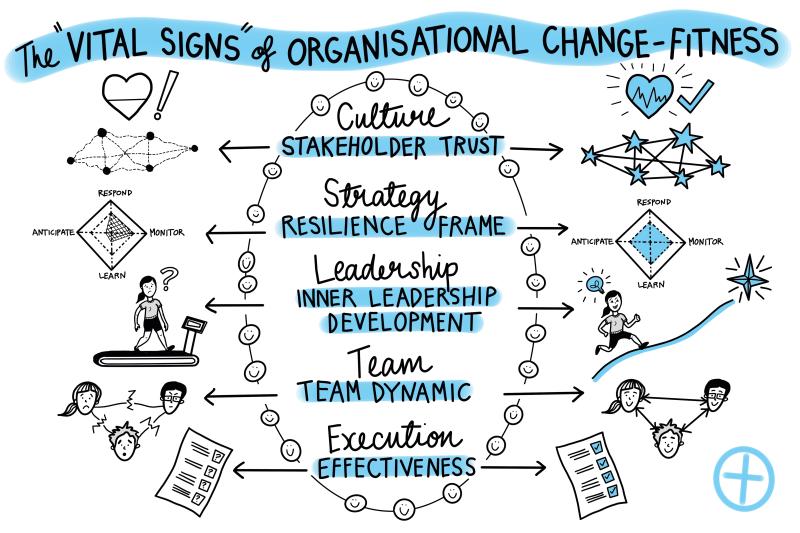Search by topic:

Over recent months many of us led well through a period of historical disruption - having switched off and on services, shifted work locations and introduced new health & safety policies radically changing our employee and client experiences. It has been a big push, and like being 15 kilometres into a Marathon we are far from through it.
Now is a critical time. Many factors are beyond our circle of influence. Some factors, like our change-fitness are however absolutely within our circle of influence. We know a team’s Change-Fit level totally changes an organisation's potential impact over time.
Like personal fitness, a number of factors need to come together to form a Change-Fit leadership team. While various references use different descriptors and terms to describe these factors, the topic areas are well established: culture, strategy, leadership, team and execution.
Cultural trust (the stakeholder ‘emotional bank account’) The emotional bank account was created by Stephen R. Covey, and refers to the balance of trust we create with our users, payers, owners and the broader community. It is an account of trust instead of money. Each action that builds trust in a relationship is equal to one deposit; however, actions that decrease trust are equal to one withdrawal. The current balance determines how well we can communicate and problem solve together. With a high balance of trust, we can engage, learn and partner with others at pace. The pursuit of our mission or cause is supported in the world around us.
Strategic frame fit (for future resilience) Many strategies and execution frameworks are built on social, economic and technological assumptions, which are not attuned to the changing dynamics, expectations, possibilities, or pace of change we are experiencing in the world. When assessing today’s strategic frame and processes for change-fitness, we refer to the fundamental definitions of organisational resilience (Patriarca, Di Gravio, Costantino, Falegnami, & Bilotta, 2018):
• Responding to any type of event (addressing the ACTUAL).
• Monitoring underway evolutions (addressing the CRITICAL).
• Learning from past failures and successes (addressing the FACTUAL).
• Anticipating future threats and opportunities (addressing the POTENTIAL).
Inner leadership development The outward manifestations of leadership positions such as office, title, past success or profile are not measures of leadership team change-fitness.
Lead measures actually include:
• A cause or effect mindset • Growth or fixed mindset • Creating space for reflection, learning, and trying new things • Evidence of revising habits, unlearning and relearning • Clarity of mission, cause and why
Assessing change-fitness provides a clear distinction between those active in the pursuit of self-development and those who are spectators (spectators refer to ‘others’ when discussing the need for change).
Team Dynamics The accountability feedback loop of team dynamics is in the outcome measures of leadership team clarity, alignment and delivery of planned results.
Lead measures include: • Team member awareness (of self and of / between each other). • Team member trust and respect. • Evidence of real conversations (open communication and working through fear of conflict). • Evidence of agreed behavioural frameworks. • Shared commitment of the mission, cause and why. • Self-accountability and team member to team member accountability. • Focus on shared results (prioritise team wins over personal performance).
Execution Effectiveness The strengths and weaknesses of the leadership team are amplified in execution effectiveness.
I am passionate about supporting teams to be able to self-diagnose these factors so they are empowered.
By